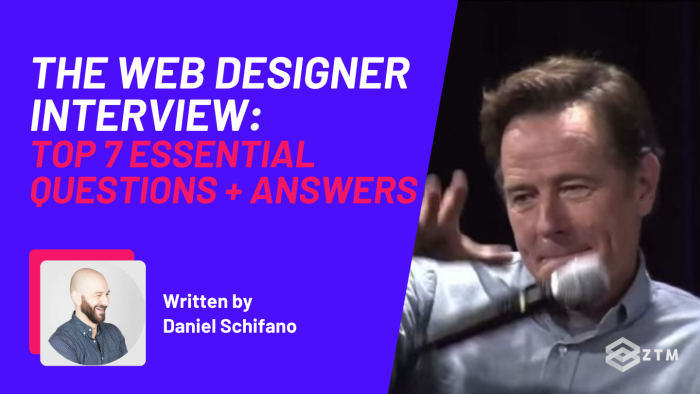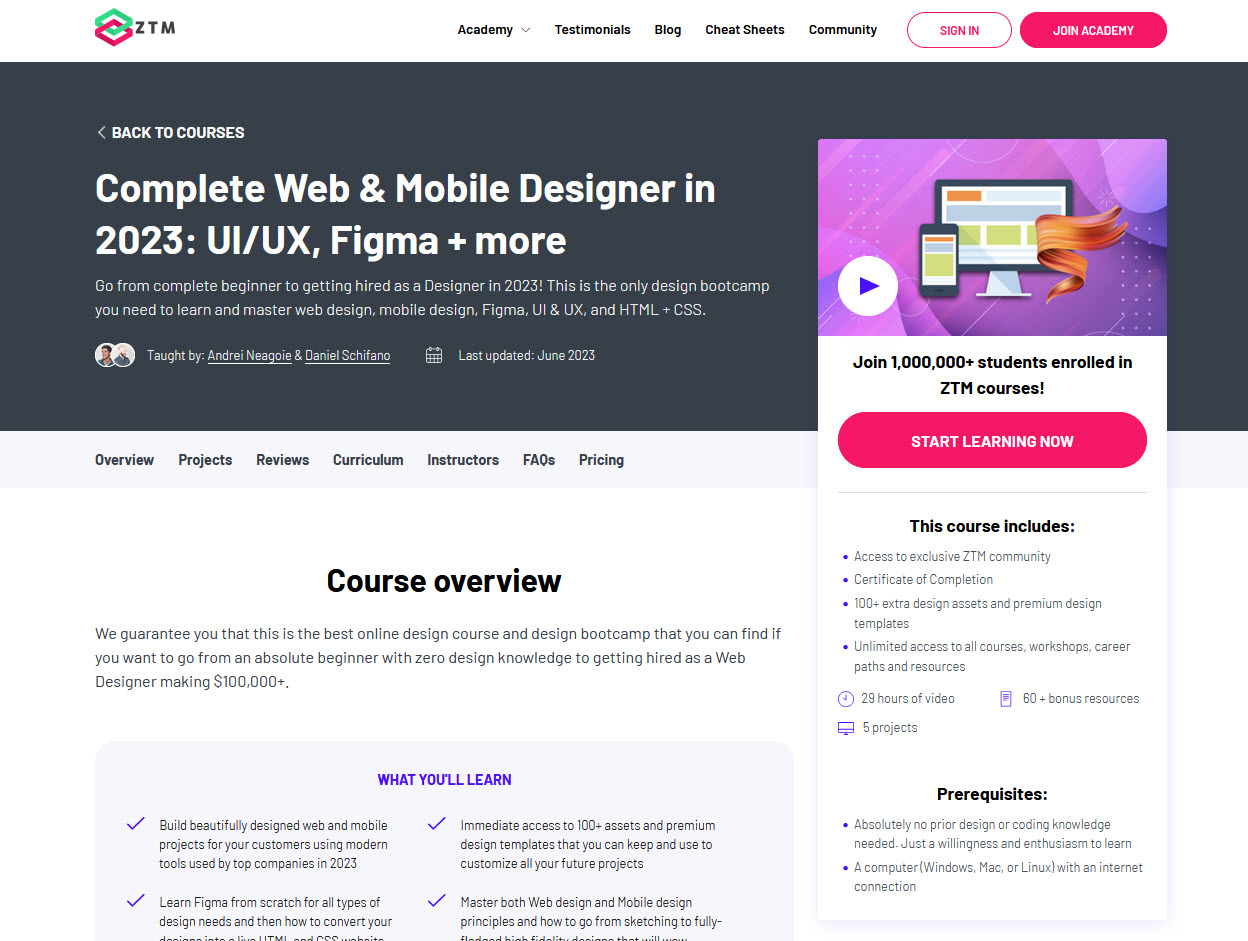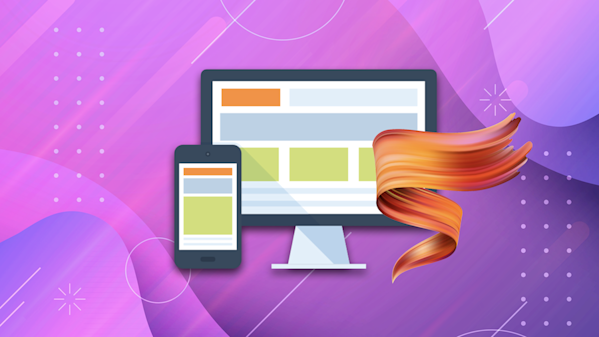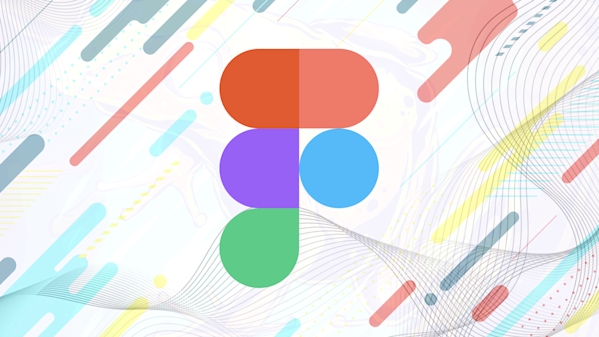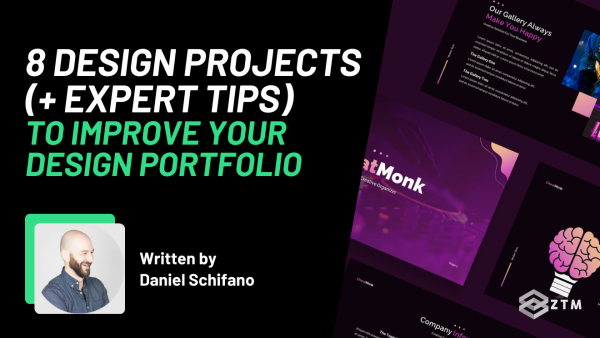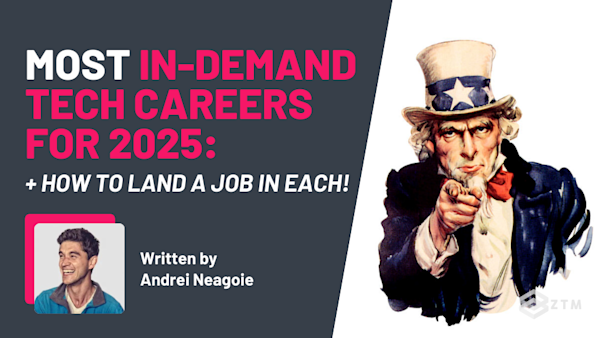So you’ve:
- Learned UI/UX design ✅
- Built a fantastic looking portfolio of projects ✅
- And are hungry for that $100,000+ design career salary 😋
You may have even applied for a few roles, and been asked to come along for an interview.
Huzzah!
The thing is, your portfolio alone won’t be enough to secure your new role. Instead, they want to see how you actually approach web design.
- What are your processes?
- Do you follow best practices?
- How do you research?
- How are you in a team?
- How do you deal with feedback?
They’ll ask all this and more, because it’s the best way for them to see that you’re not just artistic - but that you’re a team player.
So, rather than go in blind, here are 7 of the most important web designer interview questions that your interviewer will ask you with regards to web design.
Not only will we cover the questions, but we’ll also discuss the best practices that they’re looking for, and how to use these to answer each question.
By following these tips, you’ll have a better chance of impressing your interviewer and moving onto the next round of interviews, so let’s dive in!
Sidenote: If you read this guide and either struggle to answer these questions, or realize you’re missing these best practices, then be sure to check out my Complete Design Bootcamp course 👇.
I can guarantee it's the only design bootcamp you need to learn and master web design, mobile design, Figma, UI & UX, and HTML + CSS. Not only that but you'll be on a fast track you to actually getting hired ASAP.
With that out the way, let’s dive into each question.
Question #1. Walk me through your design process

This first question is a common way for interviewers to assess a candidate's design methodology.
This is why it's important to use a well-defined design process that includes:
- User research
- Ideation
- Prototyping
- Testing
- and Iteration
The interviewer basically wants to see that you’re following each important step when you design, so your response should articulate your design process clearly and concisely.
Start by explaining how you gather requirements, conduct user research, create wireframes and prototypes, and test your designs with users. Also, make sure to emphasize how your process is iterative and how you're always looking for ways to improve the user experience.
They love that you have this in mind, and that it improves over time.
Example answers:
-
“My design process involves several stages, including research, ideation, prototyping, testing, and iteration. During each stage, I set clear goals, define timelines, and prioritize tasks based on their importance and urgency. I also try to collaborate with other team members, such as developers and product managers, to ensure that everyone is aligned and the project progresses smoothly.”
-
“My design process usually starts with research to understand the problem and the user's needs. Then, I create multiple design concepts and gather feedback before selecting the best one. Once the design is approved, I create prototypes, test them, and iterate until the product is ready to be launched.”
-
“I approach designing for a new feature by first understanding the problem and the user's needs. Then, I would brainstorm ideas and sketch out possible solutions. Once I have some concepts, I would create wireframes and prototypes to test with users and gather feedback. I would iterate on the design until it meets the product's goals and the user's needs.”
If you can walk through examples of this in your portfolio, even better.
I walk my students through this entire design process all while designing real-world projects so that you actually get the experience and practice of doing this.
It's actually what you'll be doing in your job as a designer and will make answering this question in an interview a breeze.
Question #2. How do you approach designing for different platforms and devices?

Gone are the days when you only designed for desktop.
With so many digital devices and platforms available, it's imperative that web designers can design for the variety available on the market:
- Desktops
- Cell phones
- Tablets
- Smart TVs
- Etc
Each with different screen sizes, load speeds, and differences in interaction.

Obviously this is incredibly important, as you don’t want 30% of your audience not able to click buttons because they don’t show up on their phones!
So, when answering this question, let the interviewer know that you understand the distinct characteristics and limitations of each platform and device and that you're able to create designs that work well across all of them.
The process below is the best practice for this, and you can use it to help you outline your own answer:
- Research the platform and device you're designing for. Make sure you're familiar with the design guidelines, standards, and user expectations
- Plan out the user journey and flow for the platform and device. Identify any differences in user behavior and interaction between different devices, such as desktop versus mobile
- Adapt your design to fit the specific platform and device. This includes designing for different screen sizes, resolutions, and input methods
- Test your design across multiple devices and platforms to ensure that it functions and looks great everywhere
- Iterate and refine your design based on user feedback and data
- Collaborate. Work closely with developers to ensure that the design is feasible and can be implemented across different platforms and devices
Here’s a key thing that is going to come up multiple times in this guide.
Although these are best practices and processes, don’t feel like you need to robotically parrot each answer with them. It will feel weird like you're reciting something you remember vs actually having experience.
Use these processes to answer in your own language instead, touch on the most important points, and then add anything that you like to particularly focus on, with examples.
For example
-
“Before beginning any design work, I will always conduct user research to understand the needs and behaviors of the target audience on each platform or device. This allows me to tailor the design to the specific platform and ensure that the user experience is optimized for that device.”
-
“While designing for different platforms and devices, I prioritize consistency in design elements such as colors, typography, and layout to maintain a cohesive brand identity and user experience across all platforms. I ensure that users can easily recognize and navigate the interface on each platform.”
-
“I create designs that are responsive and adaptable to different screen sizes and resolutions. This approach ensures that the design remains consistent and functional across different devices and platforms.”
-
“I work closely with developers to ensure that the design is feasible and can be implemented across different platforms and devices. This collaboration helps me to understand the technical constraints and capabilities of each platform and device and make design decisions that are both functional and feasible.”
Notice how each answer is showing that you can adapt your designs to each device. They want to see that you follow the best practices, but they also want to make sure that you’re able to make it work across all screens.
Question #3. How do you stay up-to-date with emerging design trends and technologies?
This question is all about your passion and interest for web design and how committed you are to continuously learning.

Why do the interviewers care about this?
Because web design is an ever-changing field, it's super important for designers to keep up with the latest trends, best practices, and newest technology. People don’t want to hire lazy or dispassionate employees!
So showcase your commitment to learning. Chat about how you regularly read design blogs, attend conferences, and participate in online communities like Slack channels or forums.
You can obviously only say this if it's true. But if you're trying to break into the industry and are early in your career, this is something you definitely should be doing.
Be careful what you say though because good interviews will ask you follow-up questions like:
- What specific blogs do you read most often? What's one you don't like or often find yourself diagreeing with?
- What is a recent hot design trend that you think is just a fad and will be gone in a year?
- What slack community are you most active in?
- Etc.
And even better if you can explain a specific example or two of how you've actually applied what you've learned to your work to make sure your designs are always up-to-date and user-friendly.
For example
-
“I love attending design conferences and workshops, reading design blogs and publications, and collaborating with fellow designers to share ideas and best practices. I also like to experiment with new tools and technologies to see how I can improve my design process.”
-
“I always stay up-to-date with emerging design trends and technologies by attending conferences and workshops, reading design blogs and publications, and collaborating with other designers. I also like to experiment with new tools and technologies to stay ahead of the curve and make sure my design process is always improving.”
Again... the interviewer will likely ask you follow-up questions to expand further so make sure you can back it up 😉.
Question #4. How do you handle feedback from stakeholders and team members?

SCREW THEM! Who needs feedback?!
Joking. Please don't say that!
Getting feedback from stakeholders and team members is one of the most crucial parts of the design process, and you need to be able to handle it well. Some people struggle with this.
It doesn't matter if you have a great design that you love if users won’t click on it. Sometimes "ugly" designs perform the best. Your goal as a web designer isn't to design the beautiful thing, your goal is design something that drives a business goal or outcome (ie: increased conversions and revenue).
Likewise, you need to be able to communicate with stakeholders and take their feedback to help improve. But always be testing. It’s a delicate balance and you should always strive to improve that user experience.
Sometimes the c-suite might be passionate about an idea that might now work, so you need to be able to manage this.
Essentially though, this question is to show that you can take feedback graciously and not Hulk out on the messengers. You also need to be able to show your capacity to listen, communicate effectively, and collaborate to improve the design but also know when to push back a little bit because you should be the expert (vs. some random sales guy).
Here are the best practice steps you can follow when doing this:
- Listen: Actively listen to feedback and understand the concerns and perspectives of stakeholders and team members
- Clarify: Ask questions to clarify any unclear or ambiguous points. This will help you to understand the feedback more deeply and address underlying concerns
- Communicate: Explain your design rationale and how your decisions align with project goals and objectives. This will help stakeholders and team members understand why you made certain decisions and how they contribute to the project's success
- Collaborate: Work with stakeholders and team members to find solutions that address their concerns while maintaining the integrity of the design. This could involve brainstorming sessions, design workshops, or other activities
- Iterate: Refine your design based on feedback and input from stakeholders and team members. This ensures the design meets the needs of all stakeholders and is optimized for success
- Document: Keep track of design decisions by documenting feedback and changes made to the design. This ensures everyone is aligned throughout the design process
Web design is all about improving the user experience. Testing, taking feedback, and adjusting. It’s no different when it comes to shareholders or users, but you need to kill your darlings and be able to work with others.
For example
-
“I view design critiques as an opportunity to learn and improve my design skills. I listen carefully to the feedback, try to understand the underlying concerns, and use that feedback to iterate and improve the design. I also ask clarifying questions to ensure I fully understand the feedback before making changes.”
-
“I prioritize feedback based on its relevance to the project's goals and objectives. I focus on feedback that will improve the user experience or achieve the project's business objectives.”
-
“I collaborate with stakeholders and team members to develop solutions based on their feedback. I create design iterations to test and refine the solutions, and I communicate the design changes to stakeholders and team members throughout the process.”
Show that you can take feedback! If you can give real life examples of this also, it will help you stand out further.
Question #5. What's your experience with user research, and how do you use it in your design process?

User research is such an important part of the design process, and that’s why the interviewer wants to see how you use this.
The key things they want to see are:
- That you have direct experience and knowledge of user research methodologies
- As well as your ability to use the information you found to effectively to inform the design process and create successful products
It’s no good being able to do research if you don’t apply what you’ve learned right!? Especially if you’re ignoring the information and making the site worse.
To help you answer this question, here are the best practice steps. Give them a read through and use them to outline your own answer.
- Describe your experience conducting user research, including the methods you have used and the insights you have gained. It would be great to hear about examples of how you have used research to inform design decisions, such as identifying user needs, pain points, and behavior patterns. These could be surveys, interviews, usability testing, and observational studies
- Explain how you analyze and interpret user research data to inform the design process. You can mention techniques such as affinity mapping, personas, and user journey mapping (again, if you have no idea what any of this means, start taking my course where I walk you through all this)
- Discuss how you integrate user research into the design process, such as by creating design requirements, wireframes, prototypes, and user interface design. It would be great to hear examples of how you have used research insights to inform design decisions and iterate on design concepts
- Highlight your ability to collaborate with stakeholders, developers, and other team members to ensure that the design is aligned with user needs and project goals.
- Lastly, explain how you measure the success of your designs using metrics such as user satisfaction, task completion rates, and conversion rates.
Again, you don’t want to just robotically parrot this answer back to them. Instead, keep these steps in mind and explain how you do this yourself.
For example
-
“I conduct user interviews to understand the behaviors, needs, and pain points of the target audience. This helps me create user personas and user stories to guide the design process.”
-
“I analyze user data such as website analytics, user feedback, and usability testing results to identify areas for improvement and guide design decisions.”
-
“I create prototypes and conduct usability testing to validate design decisions and gather feedback from users. This helps me refine the design and ensure that it meets the needs of the target audience.”
Ideally, you’re using each of the techniques from those 3 examples above.
Question #6. Can you walk me through a particularly challenging design project you worked on and how you overcame any obstacles?

How do you cope when there's a difficult situation?
When answering this question it's important to give a detailed explanation of your project, the challenges you faced, and the strategies you used to overcome them.
This will showcase your problem-solving skills, your structured design approach, and your ability to collaborate effectively with stakeholders and iterate on designs to achieve success.
There will almost always be difficult conversations or situations like this - especially with client work. The interviewer doesn’t expect this to never happen. They know it will happen. That's why they care that you can deal with it effectively.
If you're wondering what to include in your answer, here are some key points to cover:
- Describe the project: This will help provide context on the project and the goals aimed to achieve. It helps everyone understand the challenges you faced and the strategies you used to overcome them
- Identify the challenges: Tell us about the challenges you encountered during the project, such as time constraints, technical limitations, or conflicting stakeholder requirements. Be specific about the impact these challenges had on the project and how they affected your design approach
- Strategize: Describe the strategies you used to overcome the challenges faced. This could include conducting additional research, collaborating with stakeholders to align objectives, or breaking down the project into smaller, more manageable tasks
- Iterate: Tell us how you iterated on your design to address the challenges you faced. This could include creating multiple design options, testing different approaches with users, or refining the design based on stakeholder feedback
- Implement: Explain how you implemented your design to ensure that it met the needs of the project and stakeholders
- Evaluate: Finally, let us know how you evaluated the success of your project, and what metrics you used to measure its impact. This could include things like user satisfaction surveys, task completion rates, or conversion rates
Chances are high that the interviewer will ask this question, so go ahead and think about times when this has happened to you, and how you dealt with it. Just be sure to touch on each of the elements above.
Important: Here’s a key thing that really stands out with high figure careers, and that’s showing responsibility and never placing blame.
What do I mean?
The interviewer doesn’t want to hire someone who is full of excuses and finger pointing at others. It could be that you dealt with a difficult client, but don’t say that. Heck, don't even blame the client. Instead, maybe mention how the brief changed a few times.
Then, you could shoulder that blame by saying you could have fixed this by doing more research up front for further clarity. This shows you saw the problem, handled it, learned from it, and are able to continue to improve and grow. Even better if you can show how you implemented this from then on.
See the difference? Interviewers absolutely love potential employees who act this way.
For example:
-
“One of the most challenging design projects I worked on was for a healthcare app that required me to design a user interface that was easy to use and accessible for people with disabilities. To overcome this challenge, I conducted extensive research on accessibility guidelines and best practices and collaborated closely with users with disabilities to get their feedback and insights. I also worked closely with the development team to ensure that the design was implemented correctly and met the accessibility standards.”
-
“I once worked on a project where the scope of work was not clearly defined, and the stakeholders had different expectations. To overcome this challenge, I held multiple design workshops with the stakeholders to understand their needs and expectations. I then created multiple design concepts and presented them to the stakeholders to gather feedback. Through collaboration and iteration, we were able to create a design that satisfied everyone's needs and achieved the product's goals.”
Question #7. How do you balance design and business objectives?

When answering this question, it's important to demonstrate your ability to create designs that are not only aesthetically pleasing and user-friendly, but are also aligned with the business objectives of the project.
It needs to look good, but also get sales 😜
So, make sure to showcase your ability to balance the needs of users, with the business objectives of the project.
You can display this by stating how you focus on understanding the goals of the project, collaborating effectively with stakeholders, and creating design solutions that meet both sets of objectives.
When thinking of an answer to give, make sure to touch on the following points:
- Understand the business objectives. Explain your approach to understanding the business objectives of the project. This could include conducting research, analyzing data, and working closely with stakeholders to gain a thorough understanding of the project's goals and objectives
- Identify user needs. Describe how you identify and prioritize user needs and requirements, and how you ensure that your designs meet those needs while also aligning with the business objectives of the project
- Collaborate with stakeholders. Highlight your ability to collaborate effectively with stakeholders to ensure that the design meets both their needs and the business objectives of the project. This could include creating design requirements, conducting user research, and incorporating stakeholder feedback into the design
- Create solutions. Explain how you create design solutions that balance the needs of users and the business objectives of the project. This could include creating wireframes, prototypes, and user interfaces that meet the needs of users while also achieving the business objectives of the project
- Evaluate the success of the design. Describe how you evaluate the success of the design, and what metrics you use to measure its impact on both user satisfaction and business objectives. This could include things like user satisfaction surveys, task completion rates, and conversion rates
If this is an interview for your very first web design job, and you have no direct experience of this, that’s fine. Simply by showing that you’re aware of this importance, it shows you can then use it during your work.
For example
-
“I work closely with stakeholders to ensure that the design meets their business objectives while still providing a positive user experience. This involves ongoing communication and collaboration to ensure that everyone is aligned and working towards the same goals.”
-
“I use data such as user feedback, website analytics, and usability testing results to inform design decisions that align with both user needs and business objectives. This helps me create a design that is effective and meets the goals of the project.”
To do now
As you can see, web design interviews aren’t tricky. They’re just unfamiliar territory (for now) - that you’ll learn how to navigate. You may find that you even enjoy them, because they’re great opportunities for you to showcase your design skills and your ability to solve complex design problems.
Just make sure that you follow the best practices that we’ve laid out, have a kick ass portfolio, and practice answering these 7 key questions. That way, you can be sure to touch on those important elements for each answer when you take your interview.
Also? You don’t need to know everything about Figma, or be able to answer 150+ questions on web design to get the job.
You just need to show that you have built similar work before, and have a good foundation, with the ability to learn and adapt. If you can show that, then everything else will fall into place.
And if you’re stuck for projects to make that portfolio stand out, check out my guide to #8 ‘can’t miss’ portfolio projects for web design.
And if you struggle to build them or find some of the processes here totally alien, that’s all good because I’ve got your back!
You can take my complete UI/UX design course where I’ll walk you through everything you need to go from complete beginner to getting hired as a full time designer. You'll even create 4 other portfolio projects as you go through the course.
You can even start the course for free (just scroll down to the curriculum section or use this direct link to start the course right now).
And if you have all that in place and are ready to go, then good luck in your interview!
